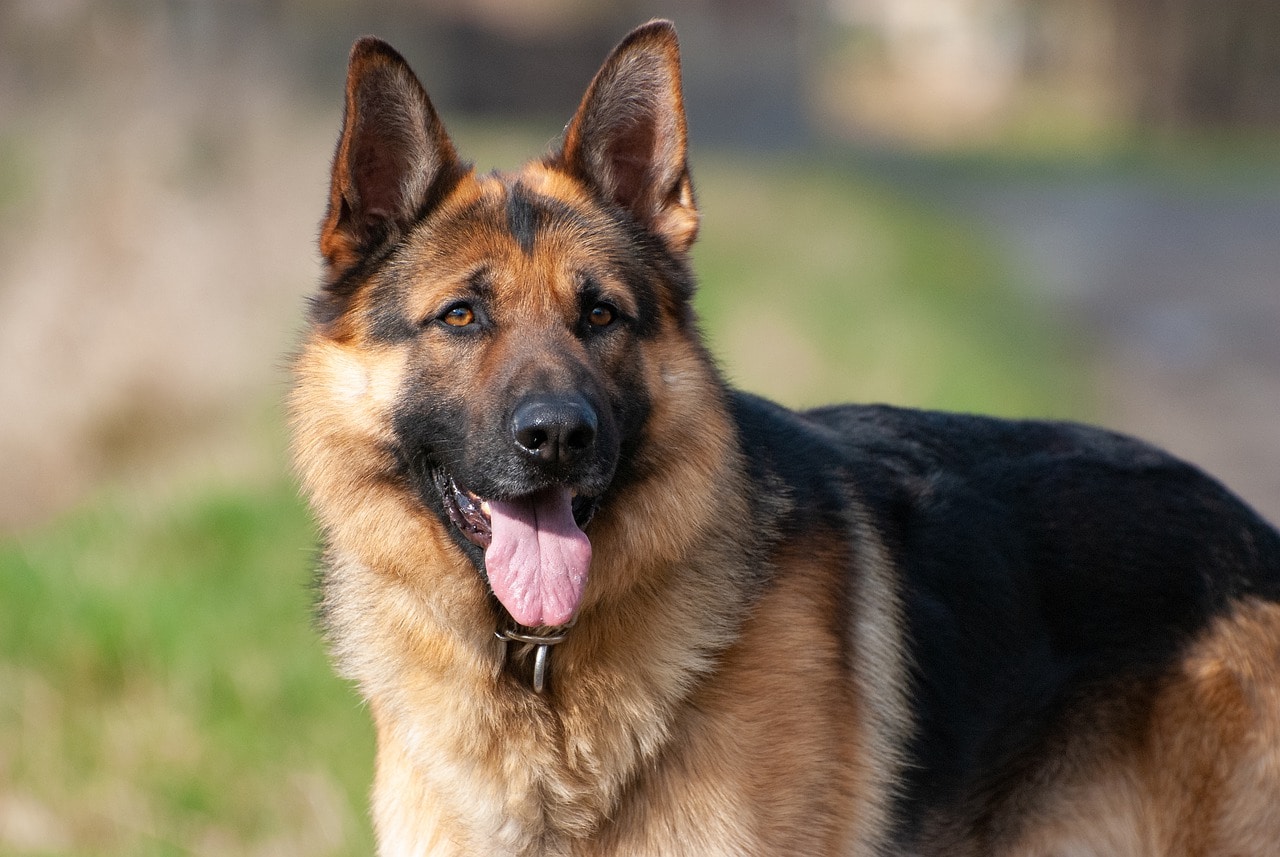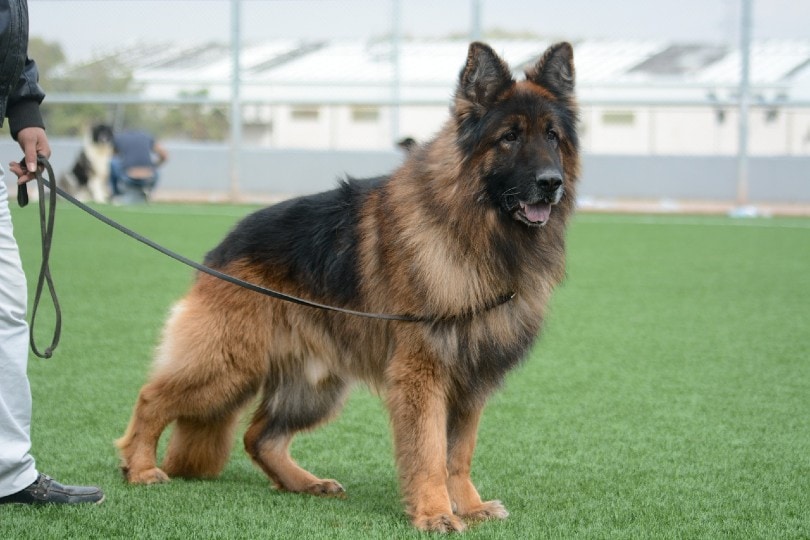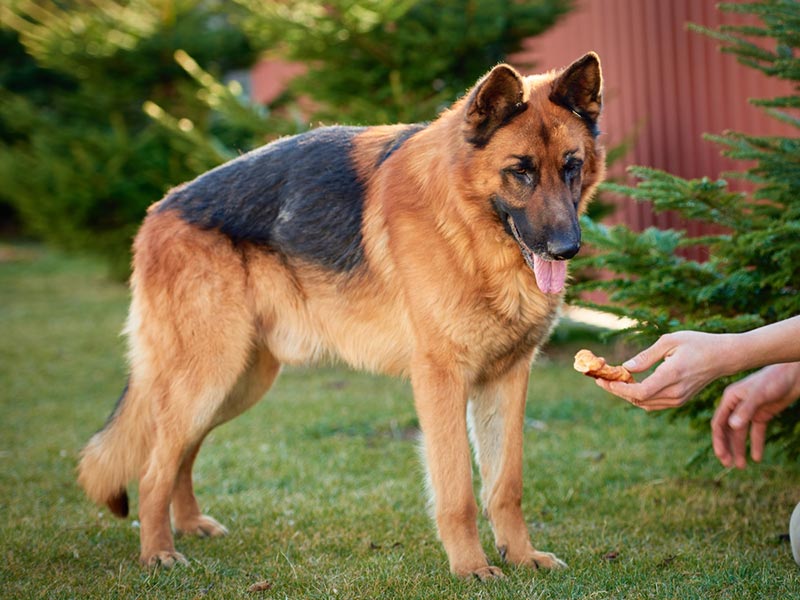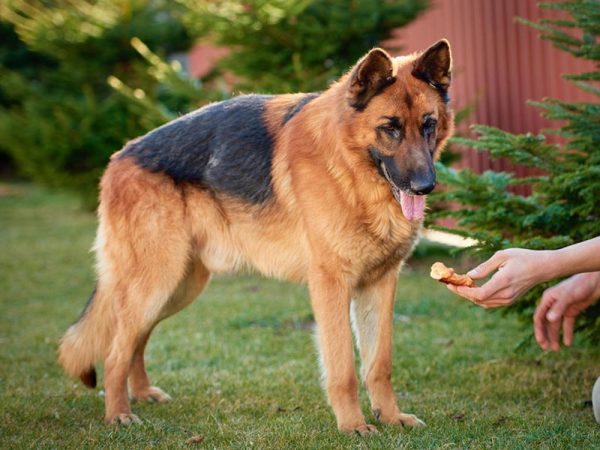Click to Skip Ahead
Giant German Shepherds are a unique and impressive breed of dog. They possess all of the desirable traits of a standard German Shepherd, such as intelligence, loyalty, and athleticism, but with an added bonus – their enormous size.
Breed Overview
Height:
26 – 34 inches
Weight:
85 – 150 pounds
Lifespan:
10 – 13 years
Colors:
White, black, tan, sable, gray, blue
Suitable for:
Active families, working roles, police and military work, search and rescue operations
Temperament:
Loyal & protective, intelligent, easy to train, friendly, gets along with other pets
Giant German Shepherds are selectively bred from larger-sized German Shepherds, aiming to create a more imposing and powerful version of the traditional breed without sacrificing their valued characteristics.
Giant German Shepherd Breed Characteristics
 The Earliest Records of Giant German Shepherds in History
The Earliest Records of Giant German Shepherds in History
The history of Giant German Shepherds can be traced back to the late 19th century, during a time of significant change and innovation in Germany. Max von Stephanitz, a German cavalry officer with a passion for dogs, played a pivotal role in the development of this impressive breed.
Von Stephanitz recognized the need for a versatile working dog that could excel in various roles, including herding, guarding, and assisting in police and military work. He believed that the standard German Shepherd had the potential to meet these requirements, but he wanted to create a larger, more powerful version of the breed.
To achieve his goal, von Stephanitz began selectively breeding larger-sized German Shepherds with desirable traits such as intelligence, strength, and a strong work ethic. He carefully chose breeding pairs that displayed these attributes, and over several generations, he successfully developed the Giant German Shepherd.

How Giant German Shepherds Gained Popularity
The rise in popularity of Giant German Shepherds can be attributed to their unique combination of size, strength, intelligence, and loyalty. As their role in human society evolved over time, these impressive dogs demonstrated their value in a variety of settings.
Initially bred for herding and guarding livestock, Giant German Shepherds proved to be highly effective in these roles due to their natural instincts, agility, and imposing presence. Word of their abilities spread quickly, catching the attention of those in need of working dogs.
As the 20th century progressed, the world began to recognize the potential of Giant German Shepherds in other important roles. Their intelligence, trainability, and loyalty made them ideal candidates for police and military work, where they excelled in tasks such as tracking, apprehending suspects, and detecting explosives and narcotics.
In addition to their success in law enforcement and military operations, Giant German Shepherds also proved to be valuable assets in search and rescue missions. Their keen sense of smell, stamina, and determination allowed them to locate missing persons and save lives in challenging environments. Furthermore, their gentle and affectionate nature made them well-suited for service dog roles, providing assistance and companionship to individuals with disabilities.
Today, Giant German Shepherds are popular family pets, offering both protection and companionship to their owners. Their versatility, combined with their striking appearance, has contributed to their enduring popularity among dog enthusiasts worldwide.

Formal Recognition of Giant German Shepherds
Although the standard German Shepherd breed was first recognized by the American Kennel Club (AKC) in 1908, the Giant German Shepherd has yet to be formally recognized as a separate breed. Despite this lack of formal recognition, the Giant German Shepherd’s unique characteristics continue to be highly sought after by dog owners and breeders alike.
To celebrate and promote the breed, many breed-specific clubs and organizations have been established, offering resources, support, and opportunities for Giant German Shepherd enthusiasts to connect. These organizations often host events such as dog shows, competitions, and educational seminars, providing a platform for the breed to gain further recognition and appreciation.
While the Giant German Shepherd may not yet have formal breed status, its impressive size, capabilities, and versatility ensure that it remains a beloved and valued member of the canine world.


Top 5 Unique Facts About Giant German Shepherds
1. They are Gentle
Despite their size, Giant German Shepherds are gentle giants, known for being friendly and good with children.
2. They Make Great Guard Dogs
They have a strong protective instinct, making them excellent guard dogs for families and properties.
3. They Need a Lot of Exercise
Giant German Shepherds require more space and exercise than their standard-sized counterparts due to their larger size.
4. They Are Great Working Dogs
Their immense size and strength make them well-suited for various working roles, including police and military work, search and rescue missions, and service dog roles.
5. They Have Own Fanclub
Although not a separate breed, Giant German Shepherds have a dedicated following and are celebrated by breed-specific clubs and organizations.
Does a Giant German Shepherd Make a Good Pet?
Giant German Shepherds make excellent pets for active families, as they are loyal, loving, and intelligent. They are easy to train and get along well with other pets. However, potential owners should be prepared for the significant space and exercise requirements of these large dogs. Giant German Shepherds need ample room to move around and plenty of daily physical activity to keep them happy and healthy.
While they are intelligent and trainable, their size and strength may pose challenges for inexperienced owners. First-time dog owners should invest in professional training and seek guidance from experienced German Shepherd owners or breeders. At least 1–2 hours of physical activity, including walks, play sessions, and mental stimulation, is recommended to maintain their health and prevent boredom.

In Conclusion
Giant German Shepherds are an extraordinary variation of the traditional German Shepherd breed. With their impressive size, strength, and intelligence, they have found a place in various working roles and as loving family pets. While not formally recognized as a separate breed, their unique characteristics have earned them a dedicated following among dog enthusiasts worldwide.
Featured Image Credit: SerPhoto, Shutterstock



 The Earliest Records of Giant German Shepherds in History
The Earliest Records of Giant German Shepherds in History






